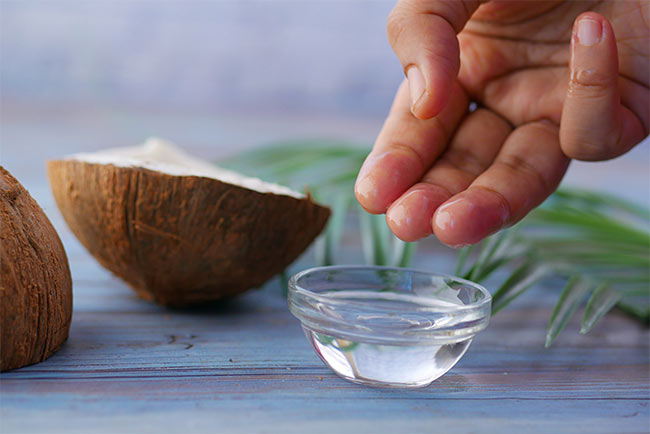We all wish waxing was a smooth and painless process, but it isn’t and after the rigors of waxing, your skin deserves the utmost care. Coconut oil, a natural skincare remedy, emerges as an exceptional choice for post-waxing treatment.
Whether it’s soothing your legs, calming the bikini area, or providing gentle care to your armpits, coconut oil’s versatility and benefits make it an ideal post-waxing companion.

The Benefits of Coconut Oil for Post-Waxing Care
Coconut oil is renowned for its skin-loving properties, particularly after waxing. Here’s why it’s so beneficial:
Reduces Inflammation
In a 2019 study exploring the anti-inflammatory and skin protective properties of virgin coconut oil, researchers found that it positively impacts the skin’s response to inflammation.
This significant finding confirms the anti-inflammatory benefits of coconut oil, which are particularly relevant in post-waxing care. Its properties not only help in reducing swelling but also alleviate discomfort associated with the waxing process.
Moisturizing Properties
Coconut oil is renowned for its deep hydration properties, particularly beneficial after waxing. Waxing not only removes hair but also strips the skin of essential oils and moisture, leading to increased vulnerability and dehydration.
A study published in Dermatitis revealed that coconut oil, much like mineral oil, can significantly increase skin hydration and the concentration of skin surface lipids, thereby reinforcing the skin’s natural barrier. This quality of coconut oil is especially valuable as waxing can exacerbate trans epidermal water loss.
By applying coconut oil post-waxing, you’re not just soothing your skin but actively helping to restore its hydration and fortify its protective layers.
Skin soothing effect
Coconut oil is not only a superb moisturizer but also a gentle soother for post-waxing skin. Its ability to calm irritation and reduce redness makes it an ideal choice for skin care after hair removal. It works really well for easing skin that’s upset or itchy, just like it does for conditions like eczema. This means it can be really helpful for the dryness, itchiness, or any discomfort you might feel after waxing.
Supports Skin Healing
Coconut oil is great for helping your skin heal after waxing. It’s full of fatty acids that are good for repairing skin. Plus, it fights off germs, which is super important to prevent infections after you wax. It even helps make more collagen, a protein your skin needs to fix any small damages.
Versatile Coconut Oil: Perfect for All Waxing Types
Coconut oil is a skincare wonder, ideal for nurturing your skin after any waxing procedure. Its soothing and healing properties make it a universal choice for post-waxing care.
In this section, we delve into the specific ways you can use coconut oil across different body areas, ensuring optimal relief and skin health after various types of waxing.
Coconut Oil After Waxing the Upper Lip
Waxing the upper lip can be tricky due to its sensitivity. This area often gets red and irritated easily. That’s where coconut oil comes in. Its anti-inflammatory properties are great for reducing redness and swelling.
When applying, remember to be gentle. Just pat the oil on the upper lip instead of rubbing it in. This gentle approach ensures you get all the soothing benefits without any extra irritation.
Face Waxing? Here’s How Coconut Oil Can Help
Waxing your face requires extra care, as the skin here is very delicate. Without the right aftercare, waxing can lead to issues like hyperpigmentation.
Coconut oil is great for preventing infections, reducing inflammation, and keeping the skin moisturized. But, it’s important to know that coconut oil might not suit everyone, especially if you have oily skin.
While it offers many benefits, coconut oil is comedogenic, which means it can clog pores. This is especially a concern for facial skin.
If your skin is dry, you can still use coconut oil, but do so sparingly. A small amount is enough to soothe and hydrate without making your skin feel greasy.
Soothing with Coconut Oil After a Brazilian Wax
After a Brazilian wax, the area becomes extremely sensitive and requires a gentle, soothing treatment. Coconut oil, with its natural and chemical-free composition, is an excellent choice for such intimate areas.
When applying, it’s crucial to prioritize hygiene to prevent any irritation. Use a clean hand or a soft cloth to apply the oil gently, ensuring that you don’t rub or press too hard. This careful application helps soothe the skin while minimizing the risk of discomfort in this delicate zone.
Bikini Wax Care: The Role of Coconut Oil
After a bikini wax, using coconut oil can be really beneficial, especially in preventing ingrown hairs. The way it works is simple: coconut oil keeps the skin soft and moisturized. This softness is key because it allows hairs to grow out more easily rather than curling back into the skin, which often happens with ingrown hairs.
Additionally, coconut oil helps maintain a healthy skin barrier. A strong skin barrier prevents hair follicles from getting clogged with dead skin cells — another common cause of ingrown hairs.
By regularly applying coconut oil to the bikini area, you’re not just soothing your skin, but also helping it stay healthy and free from those pesky ingrown hairs.
Armpits and Legs: Post-Wax Care with Coconut Oil
Coconut oil is particularly beneficial for the armpits and legs, areas that can experience more noticeable irritation after waxing. Its rich moisturizing properties are effective in soothing the skin and reducing discomfort in these regions.
For the armpits, it’s important to use coconut oil in moderation. Since this area can be more sensitive and prone to clogged pores, a light application is best.
On the legs, you can be more generous with the application to thoroughly moisturize and soothe the skin. The key is to gently massage the oil into the skin, which not only helps with hydration but also aids in calming any irritation or redness from the waxing.
Coconut Oil: The Go-To for Post-Waxing Everywhere Else
Coconut oil is not just limited to certain areas; it’s also fantastic for post-waxing care on the arms, back, and stomach. Its versatility shines through in its ability to nurture and protect the skin, regardless of the area. The moisturizing and antimicrobial properties of coconut oil play a significant role in improving skin health overall.
Whether you’re using it for specific post-wax care or as a part of your general skincare routine, coconut oil can help keep your skin in great condition, making it a suitable and beneficial choice for virtually any body part that undergoes waxing.
Precautions and Best Practices When Using Coconut Oil Post-waxing
Using coconut oil after waxing can be beneficial, but it’s important to use it correctly and safely. Here are some key things to keep in mind:
Allergy Test: Although uncommon, some people might be allergic to coconut oil, particularly those with nut allergies. Always do a patch test on a small area of skin before using it more broadly.
Skin Sensitivity: Pay attention to how your skin reacts to coconut oil after waxing. Since waxing can temporarily weaken your skin’s barrier, be cautious if your skin shows any adverse reaction to the oil.
Choose the Right Oil: Quality matters. Opt for 100% pure coconut oil to ensure you’re not applying a product with potentially irritating additives.
Cleanliness is Key: To avoid infection, apply the oil with clean hands and on a clean area. Store your coconut oil in a clean, dry place away from dust and bacteria, and make sure to close the container tightly after each use.
Oily and Acne-Prone Skin Caution: If your skin is oily or prone to acne, be cautious when applying coconut oil, especially on your face. It can clog pores and potentially lead to breakouts. Use it sparingly, if at all, in these cases.
FAQs
Can coconut oil cause breakouts after waxing?
Yes, in some cases. While coconut oil is safe for most people, it can lead to breakouts, particularly in those with oily skin. It’s a good idea to test how your skin reacts before applying it widely.
How soon can I apply coconut oil after waxing?
You should wait until any initial irritation calms down and your skin feels cooler. Applying coconut oil to skin that’s still very irritated or warm might not be comfortable.
Is coconut oil okay for all skin types after waxing?
Mostly, yes. Coconut oil works well for a variety of skin types. However, if your skin is oily or acne-prone, be cautious. Use coconut oil sparingly, or consider an alternative if you notice any negative reactions.
Overall Tips: Coconut oil is a great natural option for post-waxing care, known for its soothing and moisturizing properties. To get the best results, know your skin type and apply the oil properly. This way, you’ll enjoy the benefits while avoiding any potential drawbacks.
Related content:
What Oil Should I Use After Waxing?

Petra Nakashian (previously Kravos) is a dedicated natural health and beauty blogger, driven by the loss of her parents to cancer, which led her to meticulously research beauty product ingredients. With over 10 years of experience, her in-depth knowledge has made her a trusted expert in the field. Founder of Be Healthy Now and Green Beauty Talk, Petra recently expanded her expertise with Beauty Insights Hub, exploring a wider range of beauty treatments. Committed to transparency and honesty, her work is a vital resource for navigating the complex world of beauty.

